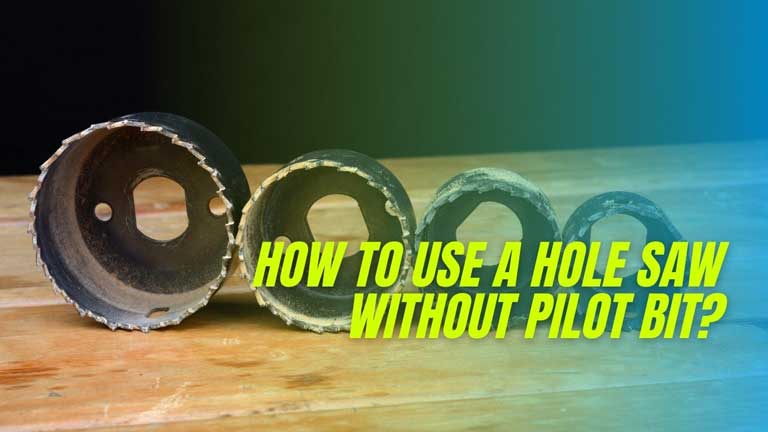If you have to drill a brittle substance or are drilling through a very thin layer, pilot bits can get in the way and crack the contact surface of the material. This is why there is a need to be able to do big diameter drilling without having to use pilot bits.
Freehand drilling is quite impossible with hole saws, meaning there must be a strategic approach that works well. A guide plate can make the job possible without any serious complications of the process. In stabilizing the process, guide plates are sleeves that the hole saw fits into.
To pull the task off, you will definitely need to have some things in place. The tools required include scrap wood of appropriate dimensions, two hand clamps, hex-head wrench (1/16 inch), cordless drill, and guide plate that matches the hole saw.
Let’s see the steps involved.

Using A Hole Saw Without Pilot Bit?
First Step
The step is about taking out the bit from your hole saw, and you will need to have your 1/16-inch hex-head wrench intact. The first thing to do is to unscrew the collet from the hole saw, then remove the bit. To remove the bit, carefully use the 1/16-inch hex-head wrench. After getting the bit out, get the collet screwed back to the hole saw, and you are ready for the next step.
Second Step
The object you want to drill needs to be secured tightly. A good clamp is a perfect option to secure an object, but not all materials can be clamped. If the object cannot be clamped, you will need to hold it firmly with your hand. Make sure your hand is safe and not exposed to harm.
Third Step
Attach the hole saw to the drill. While inserting hole saw, don’t include the pilot bit.
Fourth Step
The hole saw should be inserted into the guide plate. Turn on the whole saw and drill slowly, don’t rush things. Let the teeth decide the perimeter of the hole. Put pressure on the drill by leaning with your shoulder and for half-inch depth of the drill. When you have that, stop drilling.
Fifth Step
You need to confirm the alignment from a vertical perspective and make any adjustment that is required. Hold a drill at arm’s length and have it in the hole as you step back and make observations. When all is set, continue with your drilling.
Sixth Step
If the hole saw starts to burn or bind, you need to pull it out of the hole. After you must have done that, get dust particles blown out of the hole and continue with the drilling process.
There is something to note if you are drilling through a material that grants access to the back. Once you have around half-inch drilling to get to the other side of the object, get your scrap metal and situate it behind the wooden piece being drilled.
The scrap metal is to be held tight and parallel to the workpiece if possible. The scrap piece will get the hole saw to a halt when you finally drill through the object you are working on. This practice is an efficient move but not a necessity. Not all object permits some level of freedom after being clamped.
Is There Any Risk If I Use Hole Saw Without Pilot Bit?
Are there any risks? Yes, there are. The most prominent risk factor that is evident when you use a hole saw without a pilot bit is kickbacks. You should always be prepared for kickbacks. Protect your wrist and arms with protective clothing and precautionary measures.
Another risk is the workpiece getting loose and possibly falling off to cause an accident. To prevent that, hold the workpiece tightly or get someone to hold it well if you can use a clamp. Also, make sure the clamp is in perfect condition if you are using it.
Wear safety apparel with safety glasses, and protect yourself from overexposure to dust. Generally, maintain proper woodworking ethics, and you will be doing great.
Conclusion
The task is nothing difficult. Get the right guide plates or make them for yourself. You can work with standard drill perspectives of ¾ by 4 by 8 inches for the approximate guide.
Leave a Reply